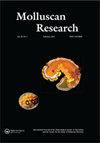日本及其邻近海域双壳类动物属,1807年(异齿目:双壳类动物科)——附三新种描述的分类学修订
IF 0.6
4区 生物学
Q3 ZOOLOGY
引用次数: 3
摘要
摘要对日本及其邻近地区(韩国、中国和台湾)的Sunetta Link, 1807的种进行了分类订正。1930年已确认的苏尼塔·贝尼亚属8种;(1),陈志强,陈志强,等。, S. cumingii E.A. Smith, 1891, S. kirai Huber, 2010, S. langfordi (Habe, 1953), S. Menke, 1843), S. nomurai Haga和H. Fukuda, n.p.。S. sunettina (jouseaume, 1891)。尽管贝氏海螺长期以来一直被误认为是来自印度洋的索安德海螺(Gray, 1825),但它与其他所有日emeroe物种的区别在于,它有一个小的、椭圆形的、膨胀的壳,后端是圆形的,还有一个宽而深凹的盾形纹饰。Sunetta crassatelliformis是日本特有的下更新世种。另一个化石种是台湾更新世的S. nomurai。Sunetta cumingii是一种来自日本西南部和台湾的鲜为人知的近代种,它与S. sunettina (= S. conceta E.A. Smith, 1891)是可分离的,两者通常被认为是同义词。在最近的6种中,只有S. sunettina广泛分布于印度-西太平洋;其他五个在日本周围的地理范围较窄。据认为,由于栖息地的丧失,苏内塔贝尼和月经夜蛾受到了威胁。本文章由计算机程序翻译,如有差异,请以英文原文为准。
The bivalve genus Sunetta Link, 1807 (Heterodonta: Veneridae) of Japan and the neighbouring waters – a taxonomic revision with the descriptions of three new species
ABSTRACT
Species of Sunetta Link, 1807 from Japan and the neighbouring regions (Korea, China and Taiwan) are revised taxonomically. Eight species of the subgenus Sunemeroe Iredale, 1930 are recognised: Sunetta beni n.sp., S. crassatelliformis Haga and H. Fukuda, n.sp., S. cumingii E.A. Smith, 1891, S. kirai Huber, 2010, S. langfordi (Habe, 1953), S. menstrualis (Menke, 1843) S. nomurai Haga and H. Fukuda, n.sp., and S. sunettina (Jousseaume, 1891). Although S. beni has long been misidentified as S. solanderii (Gray, 1825) from the Indian Ocean, it is distinguishable from all other Sunemeroe species in having a small, oval and inflated shell with a round posterior end and a broad and deeply sunken escutcheon. Sunetta crassatelliformis is a Lower Pleistocene species endemic to Japan. Another fossil species S. nomurai is known from the Pleistocene of Taiwan. Sunetta cumingii, a little-known Recent species from southwestern Japan and Taiwan, is separable from S. sunettina (= S. contempta E.A. Smith, 1891), which has often been regarded as synonymous. Amongst the six Recent species only S. sunettina is widely distributed in the Indo-West Pacific; the other five have narrower geographical ranges around Japan. Sunetta beni and S. menstrualis are thought to be threatened due to habitat loss.
求助全文
通过发布文献求助,成功后即可免费获取论文全文。
去求助
来源期刊

Molluscan Research
生物-动物学
CiteScore
1.80
自引率
10.00%
发文量
27
审稿时长
>12 weeks
期刊介绍:
Molluscan Research is an international journal for the publication of authoritative papers and review articles on all aspects of molluscan research, including biology, systematics, morphology, physiology, ecology, conservation, biogeography, genetics, molecular biology and palaeontology.
While the scope of the journal is worldwide, there is emphasis on studies relating to Australasia and the Indo-west Pacific, including East and South East Asia. The journal’s scope includes revisionary papers, monographs, reviews, theoretical papers and briefer communications. Monographic studies of up to 73 printed pages may also be considered.
The journal has been published since 1957 (as the Journal of the Malacological Society of Australia until 1993). It is free to members of the Malacological Society of Australasia and the Society for the Study of Molluscan Diversity.
 求助内容:
求助内容: 应助结果提醒方式:
应助结果提醒方式:


